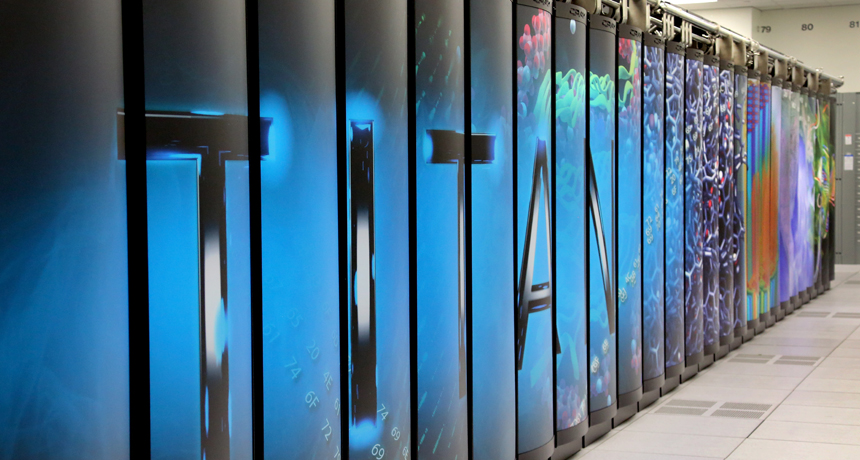Explainer: What is a computer model?

Titan, a supercomputer at Oak Ridge National Laboratory near Knoxville, Tenn., is shown here. It can perform more than 20,000 trillion calculations per second. That ability helps it run computer models of complex and dynamic systems, such as Earth’s changing climate.
Oak Ridge National Laboratory
Computers use math, data and computer instructions to create representations of real-world events. They also can predict what’s happening — or what could happen — in complex situations, from climate systems to the spread of rumors throughout a town. And computers can spit out their results without people having to wait years or to take big risks.
The scientists who build computer models start with important features of whatever events they hope to represent. Those features may be the weight of a football that someone will kick. Or it might be the degree of cloud cover typical of a region’s seasonal climate. Features that can change — or vary — are known as variables.
Next, the computer modelers identify rules that control those features and their relationships. The researchers express those rules with math.
“The math built into these models is rather simple — mostly addition, subtraction, multiplication and some logarithms,” notes Jon Lizaso. He works at the Technical University of Madrid in Spain. (Logarithms express numbers as powers of other numbers to help simplify calculations when working with very big numbers.) Even so, there’s still too much work for one person to do. “We are talking about probably thousands of equations,” he explains. (Equations are mathematical expressions that use numbers to relate two things that are equal, such as 2 + 4 = 6. But they usually look more complicated, such as [x + 3y] z = 21x – t)
Solving even 2,000 equations might take a whole day at the rate of one equation every 45 seconds. And a single mistake might throw your answer way off.
More difficult math might bump up the time needed to solve each equation to an average of 10 minutes. At that rate, solving 1,000 equations could take nearly three weeks, if you took off some time to eat and sleep. And again, one mistake might throw everything off.
In contrast, common laptop computers can perform billions of operations per second. And in just one second, the Titan supercomputer at Oak Ridge National Laboratory in Tennessee can do more than 20,000 trillion calculations. (How much is 20,000 trillion? That many seconds would come to about 634 million years!)
A computer model also needs algorithms and data. Algorithms are sets of instructions. They tell the computer how to make decisions and when to do calculations. Data are facts and statistics about something.
With such calculations, a computer model can make predictions about a specific situation. For instance, it might show, or simulate, the result of a particular football player’s kick.
Computer models also can deal with dynamic situations and changing variables. For example, how likely is it to rain on Friday? A weather model would run its calculations over and over, changing each factor one by one and then in various combinations. After that, it would compare the findings from all the runs.
After adjusting for how likely each factor was, it would issue its prediction. The model would also rerun its calculations as Friday got closer.
To measure a model’s reliability, scientists might have a computer run its calculations thousands or even millions of times. Researchers also could compare a model’s predictions with answers they already know. If the predictions closely match those answers, that’s a good sign. If not, researchers must do more work to find out what they missed. It could be they didn’t include enough variables, or relied too much on the wrong ones.
Computer modeling isn’t a one-shot deal. Scientists are always learning more from experiments and events in the real world. Researchers use that knowledge to improve computer models. The better computer models are, the more useful they can become.







